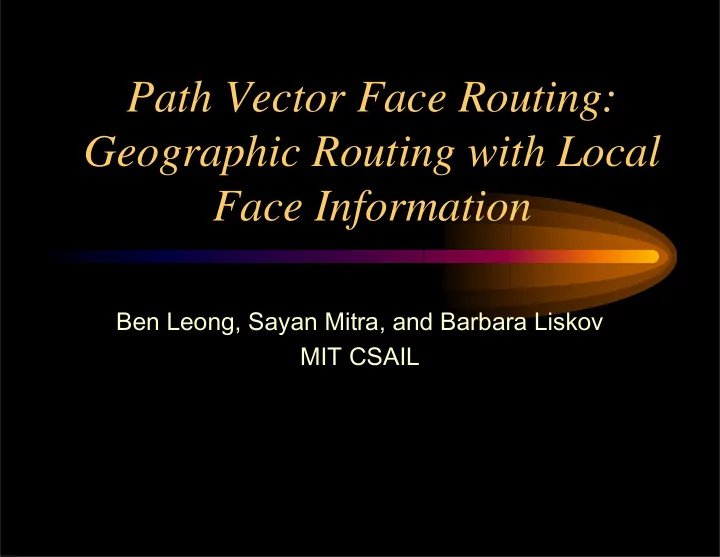

Path Vector Face Routing: Geographic Routing with Local Face Information Ben Leong, Sayan Mitra, and Barbara Liskov MIT CSAIL
Geographic Routing • Geographic routing algorithms – leverage physical location information – scale better than other ad hoc routing algorithms (Karp, 2001) – state proportional to network density, not size – can be applied using virtual coordinates (Rao et al., 2003)
Geographic Routing • Existing geographic routing algorithms – GPSR (Karp, 2001) GFG (Bose, 2001) – GOAFR+ (Kuhn, 2003) – nodes know only about immediate neighbors • Can we do better if nodes have more information?
Geographic Routing • Existing geographic routing algorithms – GPSR (Karp, 2001) GFG (Bose, 2001) – GOAFR+ (Kuhn, 2003) – nodes know only about immediate neighbors • Can we do better if nodes have more information? Yes!
Greedy Path Vector Face Routing • Our new algorithm (GPVFR): – stores small amount of additional local information (< 200 bytes) – improve maximum routing stretch over GPSR by 35 to 40% – improve maximum routing stretch over GOAFR+ by 20 to 25%
Overview • Problem • Approach • Simulation Results • Conclusion
Geographic Routing • Nodes have x-y coordinates • Nodes know coordinates of immediate neighbors • Packet destinations specified with x-y coordinates • In general, forward packets greedily
Example
Example Source
Destination Example Source
Destination Example Source
Destination Example Source
Destination Example Source
Destination Example Source
Geographic Face Routing • Problem: sometimes a packet ends up at a local minimum. • Face routing – route packet along faces of a planar subgraph • Planarization: – Relative Neighborhood Graph (RNG) – Gabriel Graph (GG) – Cross Link Detection Protocol (CLDP) (Kim et al., NSDI 2005)
Destination Example Source
Destination Example Source
Destination Example Source
Destination Example Source
Destination Example Source
Destination Example Source
Destination Example Source
Problem Nodes do not know enough to determine the“correct” forwarding direction.
Bad Choice Example Destination Source
Bad Choice Example Destination Source
Bad Choice Example Destination Source
Hypothesis By maintaining several hops of information along each planar face, we can make a better choice when deciding how to traverse a face
Greedy Path Vector Face Routing (GPVFR) • Three modes: 1. Forward greedily if possible. 2. Use face information to forward along existing face 3. Fallback on face traversal (GPSR) • Revert to greedy forwarding as soon as it is feasible
Using Face Information Destination Source
Using Face Information Destination Source
Revert to Greedy Mode Destination Source
Path Vector Exchange (PVEX) • Protocol for maintaining face information • Nodes periodically exchange path vectors with planar neighbors – h hops of information • Information is piggybacked on keepalive messages
Maintaining Face Information
Maintaining Face Information
Simulation Results • Measured 2 routing metrics: – Path Stretch – Hop Stretch • Random networks over a range of network densities • Compare to GPSR (Karp, 2001) and GOAFR+ (Kuhn, 2003) • Results for RNG and GG planarization in paper
Hop Stretch (CLDP Planarization)
Hop Stretch (CLDP Planarization) Average node degree 9
Scaling up Average node density = 9
Hop Stretch (CLDP Planarization) Average node degree 8
Scaling up Average node density = 8
Scaling up Average node density = 7
Scaling up Average node density = 6.5
Varying Path Vector Length
Maintenance Cost • Additional storage: – Small (15 to 20 extra nodes on average, < 200 bytes) – proportional to number of planar neighbors – independent of network density • Additional bandwidth: – h message exchanges (each < 200 bytes) • Planarization cost >> PVEX cost
Theoretical results 1. With full face information, we can route obliviously; 2. Without full face information, it is impossible to route obliviously.
Conclusion • Forwarding direction is critical for good performance • GPVFR achieves significantly improved routing stretch with a little extra storage.
Path Vector Face Routing: Geographic Routing with Local Face Information Ben Leong, Sayan Mitra, and Barbara Liskov MIT CSAIL
Why unlimited face information can be bad Source Destination
Why unlimited face information can be bad Source Destination
Why unlimited face information can be bad Source Destination
Why unlimited face information can be bad Source Destination
Why unlimited face information can be bad Source Destination
Why unlimited face information can be bad Source Destination
Why unlimited face information can be bad Source Destination
Why unlimited face information can be bad Source Destination
Why unlimited face information can be bad Source Destination
Theorem 1 Given a connected pair of nodes v and t in a planar graph G, assuming that every node in G completely knows all its faces, we can route from v to t obliviously
Theorem 1 Paraphrased With full face information at each node, we can route without storing state in the packets
Oblivious Routing with Full Face Information (OPVFR) • Suppose all nodes have full face information • Do: – Find target node and route towards it. – To find target node : find edge that is nearest to destination node among all faces. Node on edge that is nearer destination is target node. • Break ties in some consistent way.
Non-oblivious Routing • Need to know when we come back to the same node!
Non-oblivious Routing • Need to know when to switch back to greedy
Theorem 2 For any given non-negative integer h, there does not exist a deterministic oblivious routing algorithm that guarantees packet delivery for all planar graphs if nodes are limited to knowing only about nodes that are up to h hops away
Theorem 2 Paraphrased If nodes do not have full face information, it is impossible to always route correctly without storing some state in the packets.
Recommend
More recommend